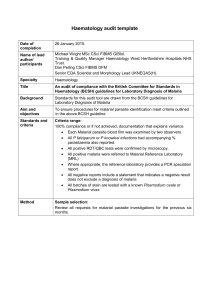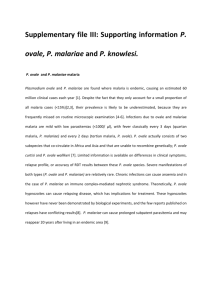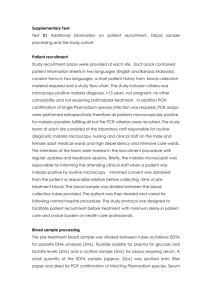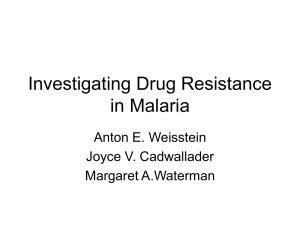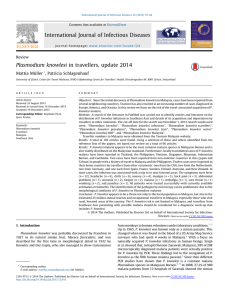Plasmodium knowlesi
advertisement
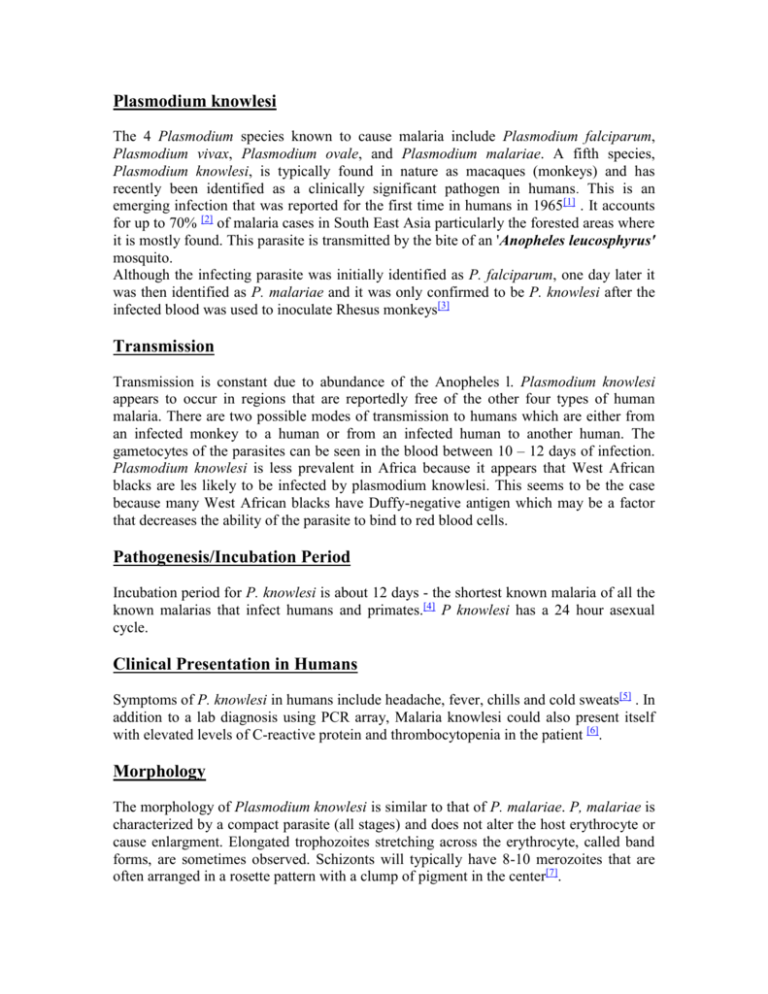
Plasmodium knowlesi The 4 Plasmodium species known to cause malaria include Plasmodium falciparum, Plasmodium vivax, Plasmodium ovale, and Plasmodium malariae. A fifth species, Plasmodium knowlesi, is typically found in nature as macaques (monkeys) and has recently been identified as a clinically significant pathogen in humans. This is an emerging infection that was reported for the first time in humans in 1965[1] . It accounts for up to 70% [2] of malaria cases in South East Asia particularly the forested areas where it is mostly found. This parasite is transmitted by the bite of an 'Anopheles leucosphyrus' mosquito. Although the infecting parasite was initially identified as P. falciparum, one day later it was then identified as P. malariae and it was only confirmed to be P. knowlesi after the infected blood was used to inoculate Rhesus monkeys[3] Transmission Transmission is constant due to abundance of the Anopheles l. Plasmodium knowlesi appears to occur in regions that are reportedly free of the other four types of human malaria. There are two possible modes of transmission to humans which are either from an infected monkey to a human or from an infected human to another human. The gametocytes of the parasites can be seen in the blood between 10 – 12 days of infection. Plasmodium knowlesi is less prevalent in Africa because it appears that West African blacks are les likely to be infected by plasmodium knowlesi. This seems to be the case because many West African blacks have Duffy-negative antigen which may be a factor that decreases the ability of the parasite to bind to red blood cells. Pathogenesis/Incubation Period Incubation period for P. knowlesi is about 12 days - the shortest known malaria of all the known malarias that infect humans and primates.[4] P knowlesi has a 24 hour asexual cycle. Clinical Presentation in Humans Symptoms of P. knowlesi in humans include headache, fever, chills and cold sweats[5] . In addition to a lab diagnosis using PCR array, Malaria knowlesi could also present itself with elevated levels of C-reactive protein and thrombocytopenia in the patient [6]. Morphology The morphology of Plasmodium knowlesi is similar to that of P. malariae. P, malariae is characterized by a compact parasite (all stages) and does not alter the host erythrocyte or cause enlargment. Elongated trophozoites stretching across the erythrocyte, called band forms, are sometimes observed. Schizonts will typically have 8-10 merozoites that are often arranged in a rosette pattern with a clump of pigment in the center[7]. Diagnosis and Diagnostic Tests P. knowlesi infections is diagnosed by examining thick and thin blood films in the same way as other malaria. The appearance of P. knowlesi is similar to that of P. malaria and is unlikely to be correctly diagnosed except by using molecular detection assays [8]in a malaria reference laboratory. There are several methods for detecting and diagnosing P. knowlesi [9]. At the moment, PCR assay and molecular characterization are the most reliable methods for detecting P. knowlesi . PCR identifies the parasite protein but this technique is not rapid and cannot be used for routine identification. Rapid diagnostic tests kits may or may not recognize P. knowlesi because of its specificity. Microscopy techniques can also be used to detect the presence of the P. knowlesi parasite in erythrocytes however this technique is not reliable because P. knowlesi can also be confused with P. malariae because of their morphological similarities. Treatment Plasmodium knowlesi is most effectively treated if the infection is detected early. P. knowlesi takes only 24 hours to complete its life cycle, which means it can result in very high parasite density in a short amount of time, which can be fatal in humans . However, the disease can be treated using already existing anti-malaria therapy such as mefloquine and chloroquine. Chloroquine is specifically preferred for non-complicated infections References 1. Chin W, Contacos PG, Coatney RG, Kimbal HR, 1965. Naturally acquired quotidian-type malaria in man transferable to monkeys. Science 149:865. 2. McCutchan TF, Piper RC, Makler MT, 2008. Use of Malaria Rapid Diagnostic Test to Identify Plasmodium knowlesi Infection. Emerging Infectious Diseases 14:11. 3. Coggeshall L.T. (1940) The occurrence of malaria antibodies in human serum following induced infection with Plasmodium knowlesi. The Laboratories of the International Health Division of the Rockefeller Foundation, New York 4. Bronner U, Divis PCS, Färnert A, Singh B, 2009. Swedish traveller with Plasmodium knowlesi malaria after visiting Malaysian Borneo Malaria Journal 8:15. 5. Bronner U, Divis PCS, Färnert A, Singh B, 2009. Swedish traveller with Plasmodium knowlesi malaria after visiting Malaysian Borneo Malaria Journal 2009, 8:15. 6. Bronner U, Divis PCS, Färnert A, Singh B, 2009. Swedish traveller with Plasmodium knowlesi malaria after visiting Malaysian Borneo Malaria Journal 2009; 8:15 7. ^ http://www.tulane.edu/~wiser/protozoology/notes/pl_sp.html#morph 8. Singh B, Lee KS, Matusop A, Radhakrishnan A, Shamsul SSG, Cox-Singh J, Thomas A, Conway DJ (2004). "A large focus of naturally acquired Plasmodium knowlesi infections in human beings". Lancet 363: 1017–24. doi:10.1016/S01406736(04)15836-4 9. Bronner U, Divis PCS, Färnert A, Singh B, 2009. Swedish traveller with Plasmodium knowlesi malaria after visiting Malaysian Borneo Malaria Journal 2009; 8:15. Case report of Swedish Traveller with Plasmodium knowlesi malaria after visiting Malaysian Borneo, published on 16th January 2009 can be traced through the following link http://www.malariajournal.com/content/8/1/15
